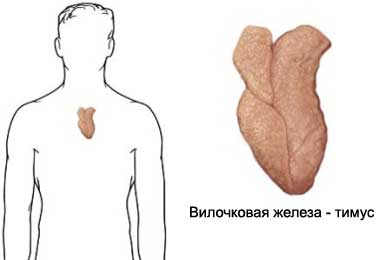Thymectomy – Removal of the thymus gland – Removal of the thymus
Description removal of the thymus
Thymectomy – surgery to remove the thymus gland (thymus). This gland is located in the upper part of the chest, for grudinoy.

Reasons for removal of the thymus
Thymus It helps control the growth of cells of the immune system. Usually, Iron is very active in children, growing up with its function is reduced. When a person is sick with myasthenia, thymus does not work properly. Myasthenia gravis is characterized by weakness of skeletal muscles of the body, and arises, when the immune system attacks the area joining the nerves to the muscles. Thymectomy is used to treat myasthenia gravis.
Thymectomy may also be done, if the thymus has a tumor (so-called thymoma). These types of tumors, associated with myasthenia gravis.
Possible complications of thymectomy
Complications are rare, but the procedure does not guarantee the absence of risk. If you plan to thymectomy, you need to know about possible complications, which may include:
- Bleeding;
- Infection;
- Damage to other organs;
- Nerve Damage;
- Respiratory failure.
Factors, that may increase the risk of complications:
- Smoking;
- Age: 60 and older.
How is the removal of the thymus gland?
Preparation for the procedure
- The doctor appointed the following:
- Roentgen – test, which uses X-rays to take pictures of structures inside the body;
- Blood tests;
- Urine;
- Tests of muscle strength;
- Breathing tests;
- Follow a special diet, which may include refusal of food and fluids before surgery;
- Take prescribed medications;
- Tell your doctor about taking any medications. A week before surgery, perhaps, you need to stop taking certain drugs:
- Aspirin or other anti-inflammatory drugs;
- Blood thinners, such as clopidogrel (Plaviks) or warfarin.
We need to organize a trip for the operation and back home from the hospital. Also organizes home care during the recovery period.
Anesthesia
When applied thymectomy general anesthesia, which supports a patient in the sleep state during operation.
Procedure removal of the thymus gland
There are three common methods of thymectomy:
- Transsternalny method – in the skin of the chest will make the cut. The sternum is severed. The thymus gland is separated from the surrounding tissues and removed. The incision will be closed sutures or staples;
- Transcervical method – a small incision is performed on the entire lower part of the neck, just above the sternum. The thymus gland will be removed. The incision will be closed sutures or staples;
- Video-supporting thoracic surgery or robotic thoracic surgery – it is the least invasive surgery options. In the operation, a few small incisions. Through one of the incisions a tiny camera will be inserted, which will transmit the image to a monitor in the operating room. For surgery use robotic arms. Special tools will be inserted through the remaining incisions to remove the thymus. After, as the thymus gland removed, incisions are sewn up.
Immediately after removal of the thymus
You will be directed to the recovery room for observation.
How long will thymectomy?
About 1-3 o'clock.
Thymectomy – Will it hurt?
Anesthesia will block pain during surgery. You will experience some pain after the anesthetic action. The doctor will give you pain medicine.
The average time of stay in the hospital after the removal of the thymus gland
Usually the duration of stay of 1-3 day. The doctor can extend the period of stay, If there are complications.
Care after the removal of the thymus
Care in a hospital
Will be administered through the IV fluids and medications needed. You will be instructed, how to practice deep breathing and coughing, Cleaning lung. The nurse will measure the strength of muscles and breathing, to determine the effectiveness of the operation.
Home Care
Recovery time depends on the patient's disease. Recovery may take all 1-2 of the week, but sometimes it takes about three months, before you can get back to work or school. Ask the doctor, when it is safe to shower, bathe, or to expose the surgical site to water. Be sure to follow your doctor's instructions.
If the operation has been made for the treatment of myasthenia gravis:
- Recovery of muscle strength may take several months to several years;
- It is important to work with a neurologist during the recovery period, to regulate the intake of drugs.
Contact your doctor after removal of the thymus
After discharge from the hospital need to see a doctor, If the following symptoms:
- Signs of infection, including fever and chills;
- Redness, edema, strong pain, bleeding, or discharge from the incision;
- Pain, which does not pass after taking pain medication appointed;
- Cough, shortness of breath or chest pain;
- Pain, burning, frequent urination or persistent blood in the urine;
- Constant nausea and / or vomiting;
- Pain and / or swelling of the legs, calves and feet;
- Other worrisome symptoms.
